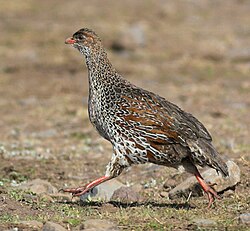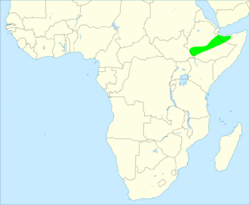Biology:Chestnut-naped spurfowl
| Chestnut-naped spurfowl | |
|---|---|

| |
| Scientific classification | |
| Domain: | Eukaryota |
| Kingdom: | Animalia |
| Phylum: | Chordata |
| Class: | Aves |
| Order: | Galliformes |
| Family: | Phasianidae |
| Genus: | Pternistis |
| Species: | P. castaneicollis
|
| Binomial name | |
| Pternistis castaneicollis (Salvadori, 1888)
| |

| |
geographic distribution
| |
| Synonyms | |
|
Francolinus castaneicollis protonym | |
The chestnut-naped spurfowl (Pternistis castaneicollis) is a species of bird in the pheasant family Phasianidae. At 33–37 cm (13–15 in) in length and weighing 550–1,200 g (19–42 oz), it is a large species of spurfowl.[2] It is found in Ethiopia and Somaliland. The population is believed to be stable but according to the International Union for Conservation of Nature (IUCN) there is insufficient data to make an estimate of the population.
Taxonomy
The chestnut-naped spurfowl was described in 1888 by the Italian zoologist Tommaso Salvadori based on a specimen collected near "Lago Ciar-Ciar" (now Haro Ch'erch'er Hayk') in the Ahmar Mountains of central Ethiopia. He coined the binomial name Francolinus castaneicollis.[3][lower-alpha 1] The species is now placed in the genus Pternistis that was introduced by the German naturalist Johann Georg Wagler in 1832.[4][5] The specific epithet castaneicollis combines the Latin castaneus meaning "chestnut-brown" and the Modern Latin -collis meaning "necked".[6] The chestnut-naped spurfowl is monotypic: no subspecies are recognised.[5]
Notes
References
- ↑ BirdLife International (2016). "Pternistis castaneicollis". IUCN Red List of Threatened Species 2016: e.T22728231A94975710. doi:10.2305/IUCN.UK.2016-3.RLTS.T22728231A94975710.en. https://www.iucnredlist.org/species/22728231/94975710. Retrieved 12 November 2021.
- ↑ Dunning Jr., John B. (1992). CRC Handbook of Avian Body Masses. Boca Raton, Florida, USA: CRC Press. ISBN 978-0-8493-4258-5.
- ↑ 3.0 3.1 Salvadori, Tommaso (1888). "Uccelli dello Scioa e dell 'Harar raccolti Dal Dott. Vincenzo Ragazzi" (in Italian, Latin). Annali del Museo Civico di Storia Naturale di Genova. 2nd series 26: 525–544 [542–543]. https://biodiversitylibrary.org/page/29874752.
- ↑ Wagler, Johann Georg (1832). "Neue Sippen und Gattungen der Säugthiere und Vögel" (in German, Latin). Isis von Oken: cols 1218–1235 [1229]. https://biodiversitylibrary.org/page/26455534.
- ↑ 5.0 5.1 Gill, Frank; Donsker, David; Rasmussen, Pamela, eds (2020). "Pheasants, partridges, francolins". IOC World Bird List Version 10.1. International Ornithologists' Union. https://www.worldbirdnames.org/bow/pheasants/.
- ↑ Jobling, James A. (2010). The Helm Dictionary of Scientific Bird Names. London: Christopher Helm. p. 93. ISBN 978-1-4081-2501-4. https://archive.org/details/helmdictionarysc00jobl_997.
External links
Wikidata ☰ Q1261619 entry
 |


